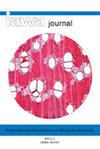Comparative anatomy vs mechanistic understanding: how to interpret the diameter-vulnerability link
IF 3.5
3区 农林科学
Q2 FORESTRY
引用次数: 0
Abstract
Summary Results from comparative and ecological wood anatomy combined with a number of experimental studies on plant hydraulics have led to a pervasive and longstanding assumption that wider-diameter vessels are more vulnerable to drought-induced embolism than narrower vessels. Although we agree that wider vessels tend to be more vulnerable than narrower vessels within stems and within roots across most species, our current understanding of the diameter-vulnerability link does not offer a mechanistic explanation for why increased vessel diameter should consistently lead to greater vulnerability or vice versa. Causes of drought-induced embolism formation and spread likely operate at the nano-level, especially at gas-liquid-surfactant interfaces inside intervessel pit membranes. We evaluate here new perspectives on drought-induced embolism and its key anatomical and physico-chemical drivers, of which vessel diameter is one of the parameters involved, although its linkage to embolism vulnerability is likely indirect. As such, the diameter-vulnerability link does not imply that species with on average wider vessels are consistently more susceptible to drought-induced embolism compared to species with narrower vessels. Scientific priorities for future progress should focus on more accurate predictions of how water transport in plants is affected by drought, which requires a better mechanistic understanding of xylem network topology and biophysical processes at the nano-scale level in individual vessels that determine embolism formation and spread.比较解剖学与机械理解:如何解释直径-易损性的联系
比较和生态木材解剖结合植物水力学实验研究的结果导致了一个普遍和长期的假设,即直径较宽的血管比直径较窄的血管更容易受到干旱引起的栓塞。虽然我们同意在大多数物种中,茎和根内较宽的血管往往比较窄的血管更脆弱,但我们目前对直径-脆弱性联系的理解并没有提供一个机制解释,为什么血管直径的增加总是导致更大的脆弱性,反之亦然。干旱引起的栓塞形成和扩散可能在纳米水平上起作用,特别是在血管间坑膜内的气液表面活性剂界面。我们在此评估了干旱诱发栓塞及其关键解剖和物理化学驱动因素的新观点,其中血管直径是所涉及的参数之一,尽管其与栓塞易感性的联系可能是间接的。因此,直径-脆弱性联系并不意味着血管平均较宽的物种比血管较窄的物种更容易受到干旱引起的栓塞的影响。未来进展的科学重点应该集中在更准确地预测植物中的水分运输如何受到干旱的影响,这需要更好地理解木质部网络拓扑结构的机制,以及在纳米尺度上单个血管中决定栓塞形成和扩散的生物物理过程。
本文章由计算机程序翻译,如有差异,请以英文原文为准。
求助全文
约1分钟内获得全文
求助全文
来源期刊

IAWA Journal
农林科学-林学
CiteScore
3.40
自引率
15.80%
发文量
26
审稿时长
>36 weeks
期刊介绍:
The IAWA Journal is the only international periodical fully devoted to structure, function, identification and utilisation of wood and bark in trees, shrubs, lianas, palms, bamboo and herbs. Many papers are of a multidisciplinary nature, linking
 求助内容:
求助内容: 应助结果提醒方式:
应助结果提醒方式:


